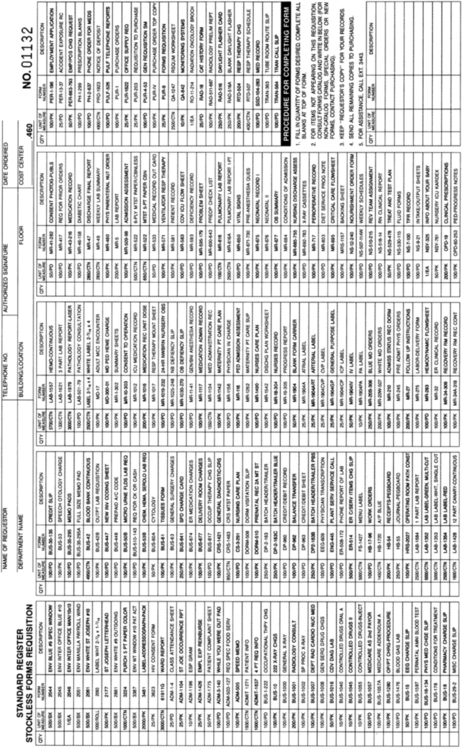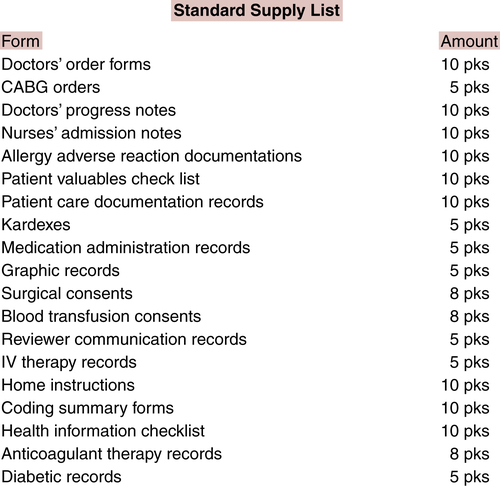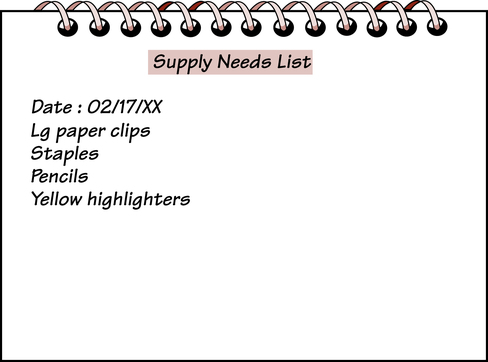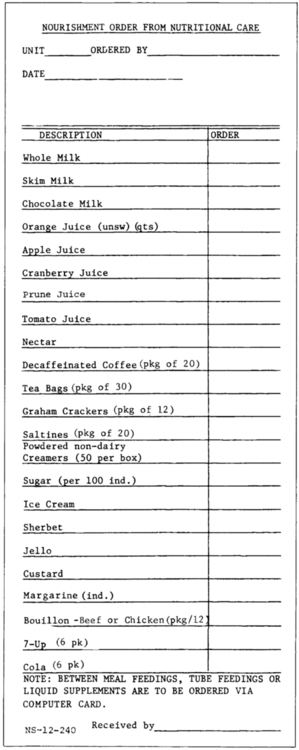On completion of this chapter, you will be able to: 1. Define the terms in the vocabulary list. 2. Write the meaning of the abbreviations in the abbreviations list. 3. List five areas of management responsibilities related to the hospital unit coordinator (HUC) position. 4. Name five hospital departments that provide supplies to the nursing unit, identify the department that would provide each supply from a list of supplies, and describe the systems used for restocking supplies. 5. Identify the appropriate hospital department that the HUC would notify, using a list of nursing unit equipment needing repair and problems that need to be resolved. 6. Identify the emergency equipment that is located on a nursing unit, and give an example of reusable patient equipment that would require a daily charge. 7. Explain the importance of the change-of-shift report, and list five items that would be recorded on the census worksheet for quick reference. 8. Briefly explain a method used to record the location of patients and patients’ charts, and discuss why it is necessary to keep a record of this information. 9. Describe the HUC’s responsibilities regarding the admission, discharge, and transfer (ADT) sheet, the ADT log book, and the patient labels, and identify daily nursing forms that the HUC may prepare when using paper charts. 10. List seven steps to follow when dealing with visitors’ complaints. 11. Describe the process for sending and receiving medical records; list five guidelines for scanning medical records into the patient’s electronic medical record (EMR) and seven guidelines for filing medical records in the patient’s paper chart. 12. Explain the process of retrieving diagnostic test results with and without the EMR. 13. Given a list of several HUC tasks, identify those that would have a higher priority and those that would be of lower priority. 14. List 12 time management tips for the HUC. 15. Define two types of stress, and provide an example of each. 16. List five techniques for dealing with stress on the job. 17. Identify two common work-related injuries and five guidelines for preventing workplace injuries. 18. List four items that should be within reaching distance of the HUC’s desk area and at least six reference materials that would be located on the computer or in hard copy on the nursing unit. 19. Discuss the purpose of continuous quality improvement (CQI). Admission, Discharge, and Transfer Log Book (ADT log book) Admission, Discharge, and Transfer Sheet (ADT Sheet) Central Service Department (CSD) Charge Slip Central Service Department (CSD) Credit Slip Central Service Discrepancy Report Continuous Quality Improvement (CQI) Five-Step Problem-Solving Model A step-by-step process designed to solve problems. A sheet of paper used by all nursing unit personnel to jot down items that need reordering. 1. Management of nursing unit supplies and equipment 2. Management of activities at the nurses’ station 3. Management of patient medical records 4. Management related to the performance of tasks Nurses’ station: Used as a reception desk and is the hub of activity. Contains the HUC workstation, and computers where doctors, nurses, and other health care professionals enter orders and other documentation into patients’ electronic or paper records. Equipment located in the nurses’ station includes computers, printers, scanner, telephones, and fax machine (see Fig. 1-1 on p. 3). Patient rooms: Used to admit patients for treatment and care (medical, surgical, trauma, or obstetric patients). Unit kitchen: Used to store food items and to prepare beverages and snacks for patients. Linen room or cart: Used to store linens. Employee lounge: Used by nursing unit personnel for conferences, breaks, and other activities. Report room: Room used by nursing personnel who are going off duty to give a change-of-shift report to personnel who are coming on duty (report may be provided in person or may be tape-recorded). Medication room or computerized medication cart: Used to store and to prepare medications for administration by nursing personnel. Treatment room: Room used to perform invasive procedures such as lumbar puncture (spinal tap). Central service closet or cart: Used to store items such as gauze pads, elastic bandages, adhesive tape, alcohol pads, masks, and protective gloves. Utility room: Used for the storage and care of patient care equipment. Most hospitals have two utility rooms. One is referred to as a contaminated or “dirty” utility room, where used equipment such as intravenous pumps and air mattresses are stored until picked up by CSD personnel to be cleaned and sterilized for distribution as needed. The other is used as a storage room where frequently used equipment, such as intravenous poles, bedside commodes, and bedpans, is stored. Visitor waiting room: Used as a visiting area for patients’ relatives and friends Conference room: Used for patient care conferences or as a place where a doctor or a pastor can speak to family members in private. Purchasing department supplies consist of nonnursing items, such as paper chart and requisition forms, pencils, staples, flashlights, and numerous other items. Figure 7-1 illustrates an example of a purchasing department order form. Items received from the purchasing department are paid for from the nursing unit budget. A cost control center number for the nursing unit is placed on all requisitions issued by the unit. Restocking of purchasing department supplies is done weekly or bimonthly and is the most demanding of all supply tasks. It is important to order what is needed in a timely manner. Central service department (CSD) supplies used for nursing procedures that are stored in the CSD department need to be requisitioned and are charged to the patient. (See Fig. 11-2 for an example of a CSD computer screen.) Smaller items, such as adhesive bandages, tongue blades, alcohol, and sponges, are covered by the nursing unit’s budget. Most hospitals use a standard supply list (Fig. 7-3), a computerized or written record of the quantity of each item currently needed by the nursing unit to last until the next supply order date. Standard supply lists are sometimes located inside cupboard doors or at the bottom of drawers where supplies are stored. To determine and order the number of supplies needed, simply compare the quantity on the standard supply list with the quantity of the item on the shelf, and requisition the difference. Keep in mind that the standard supply for many items may change and the standard supply list must be updated to reflect the changes. Another suggestion is to maintain on the nursing unit bulletin board a supply needs list for items (other than those maintained by the CSD) and ask all nursing unit personnel to record supplies that are running low (Fig. 7-4). This list may be used as a reference for items needed when you are ordering supplies for the nursing unit. The HUC may take inventory of nutritional care supplies such as crackers, juices, milk, coffee, and tea and order appropriate quantities for the nursing unit.
Management Techniques and Problem-Solving Skills for Health Unit Coordinating
Abbreviation
Meaning
ADT log book
book used to record all admissions, discharges, and transfers on a nursing unit
ADT sheet
form used to record admissions, discharges, and transfers on a nursing unit on a daily basis
CQI
continuous quality improvement
Management of Nursing Unit Supplies
Common Areas Located on a Typical Nursing Unit
Departments that Provide Nursing Unit Supplies
Purchasing Department

Central Service Department
Systems Used in Determining Need and Restocking Unit Supplies


Nurse Key
Fastest Nurse Insight Engine
Get Clinical Tree app for offline access




